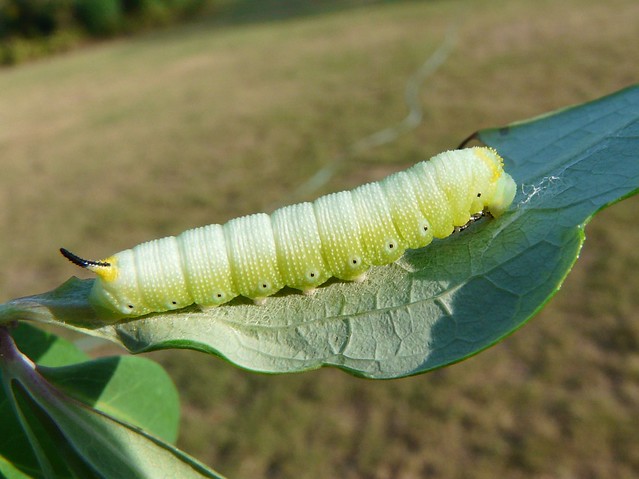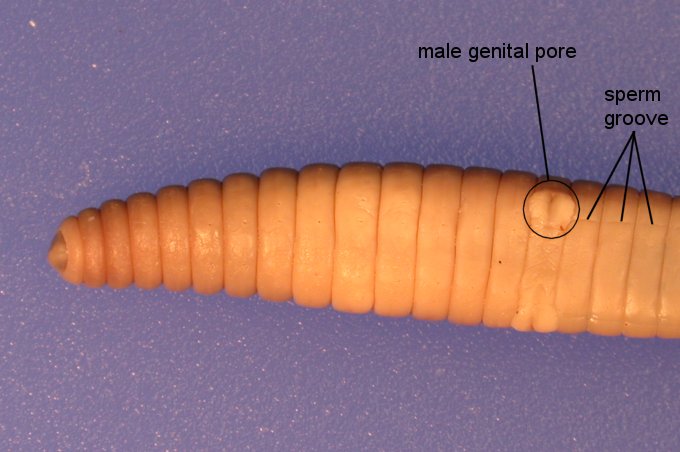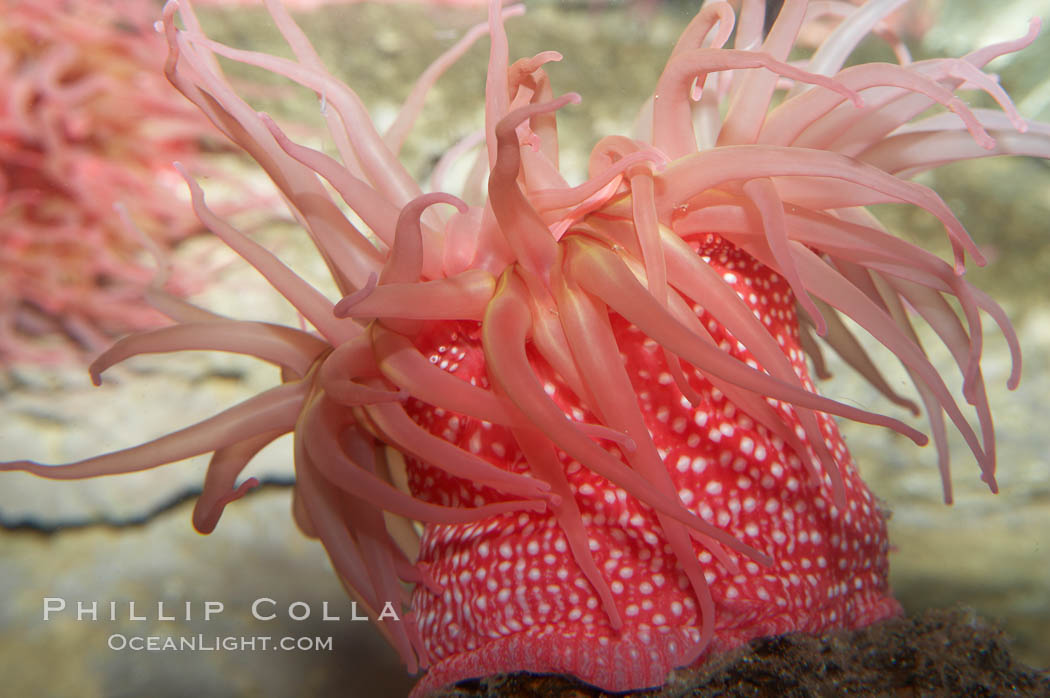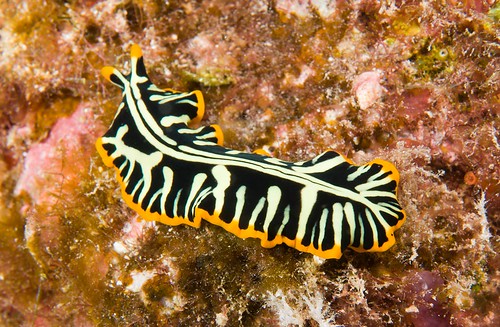Hummingbird Clearwing Moth
Hemaris Thysbe
The Hummingbird Clearwing Moth is one of nature's very best examples of mimicry and delicate beauty. Like the hummingbird, it hovers in the air to sip nectar from sweet flowers, beating its wings at rapid speeds so fast that they seem a blur. Although these moths share many similarites with the Hummingbird, that is not why they are called Hummingbird Moths. It is because, when sighted, they are often mistaken for hummingbirds themselves!
Phylum: Arthropoda
Class: Insecta
Essential Functions
1) Body Structure
Adult Hummingbird Clearwing Moths grow to about 2 inches in length with wings that span 1-2 inches. Their thorax is olive in colour dorsally, and yellow ventrally, with a burgundy coloured abdomen ending in a fan-like tail of setae. The moth has one pair of compound eyes, one pair of strongly clubbed antennae, six legs and a proboscis. Their most interesting physical feature, as denoted by their name, is their clear wings. Their wings are scaled like most moths when they first leave their cocoon, but once they have taken first flight, the scales fall off and leave behind beautiful clear wings rimmed with orange-burgundy borders and veins. Hummingbird Clearwing larvae are most commonly green, brown and gray, but other colours do exist.
2) Digestion/Feeding
Adult Hummingbird Moths snack on the nectar of their favourite flowers. These include Japanese Honeysuckle, Beebalm, Red Clover, Lilac, Phlox, Snowberry, Cranberry and Blueberry plants and Thistles. Their larvae enjoy the leaves of these same plants. An adult moth uses a specialized mouthpart, a long, thin, needle like proboscis to suck up the nectar.
Like all moths, the Hummingbird Clearwing Moth's digestive system consists of a foregut, hindgut and midgut. After nectar is sucked up through the proboscis, it is passed into the esophagus and then stored in the crop for a short time. After this it continues on to the gizzard and then through the valve to the midgut and to the stomach where main digestion and absoption of nutrients takes place. The hindgut will then absorb the water and nutrients from the nectar that the midgut did not and pass the waste out through the anus.
3) Circulation
Hummingbird Clearwing Moths have an open circulatory system where blood is passed through blood vessels and body cavities called sinuses. Moth blood is actually green due to the fact that it is not oxidized when carried through the dorsal vessel. The moth has one heart that pumps blood to the rest of the body.
4) Respiration
Hummingbird Clearwing Moths breathe through thoracic and abdominal spiracles connected to tracheal tubes that diffuse oxygen to all body tissues and diffuse carbon dioxide out of the body through the spiracles.
5) Excretion
Moths excrete food wastes out through the anus. They also possess a set of Malpighian tubules which eliminate nitrogenous wastes from the blood, passing them out through the anus along with food wastes.
6) Movement
Hummingbird moths have a very unique way of moving unlike any other moth in their order. Their wings are made of many thin layers of chitin and they beat them very rapidly to hover in the air. Their wings can reach speeds of 30 beats per second and 30 miles per hour!
Hummingbird Clearwing Moth reproduction is internal and the moth breeds an average of 2-3 times per years. The moths detect mates by smell and sight, and once found, have been known to engage in a courtship chase in which the male and female fly through the air spiralling upward or flying low to the ground. Once the female's eggs are fertilized, she will lay them on a host plant. A host plant is one that the hatched larvae can feed upon (leaves) and are often the same plants it feeds on in adulthood. (nectar) The female Hummingbird Moth can lay up to 200 eggs, each on a different host plant! The eggs hatch into larvae within 6-8 days and after a while undergo complete metamorphosis, spinning a loose,glossy cocoon from which it will emerge an adult Hummingbird Clearwing Moth.
Other Important Information
- Hummingbird Clearwing Moths are bilaterally symmetrical.
- They have 3 germ layers: the mesoderm,(a middle layer of cells that forms
the muscles and interior organs) endoderm, (cells on inside of gastrula that become the lining of the gut) and ectoderm. (cells on outside of gastrula that become the body covering).
- Other organsims found within the same phyla as Hummingbird Moths (Arthropoda) include beetles, centipedes, spiders, butterflies, grasshoppers and many, many more.
- Hummingbird Moths are protostomes. In protostome development, the embryo forms a dent on one side called the blastopore which deepens to become the archenteron which is the first growth of the gut. The original dent becomes the anus of the moth and the gut tunnels through the embryo to form the mouth of the moth.
Ecological Significance
- Hummingbird Moths are important pollinators and aid in seed production.
- They are food for a variety of wildlife including other insects, spiders, frogs, toads, lizards, shrews, hedgehogs and birds. That is, IF they can catch them!
- Hummingbird Moth caterpillars eat certain plants' leaves, causing them to evolve characteristics which make them less appealing to the larvae. An example might be developing bad tasting chemicals on the surface of its leaves that deter the animals from eating them.
- Hummingbird Clearwing Moths are useful as an indicator species as they are so abundant but are also quite sensitive to environmental change.
Interesting Facts
- Hummingbird Clearwing Moths are seen on clear, sunny days unlike most moths because, like humans, they are diurnal and sleep at night.
- The Hummingbird Moth mimics the Hummingbird in order to trick predators into staying away from it.
- It lives in Alaska, the Northwest Territories, BC, Oregon, Maine, Newfoundland, Florida and Texas.
- Hummingbird Moths are known for being quite comfortable around humans and some will even land on you if you have some tasty nectar to offer!
So why do I love Hummingbird Clearwing Moths? Because they defy our expectations with their fascinating mimicry and are adorable little creatures.










.JPG)




















